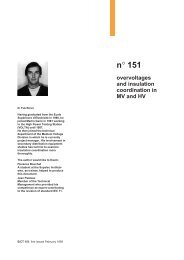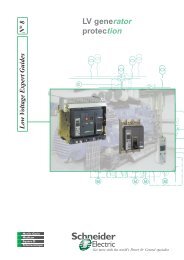sepam 20 user manual - Schneider Electric
sepam 20 user manual - Schneider Electric
sepam 20 user manual - Schneider Electric
Create successful ePaper yourself
Turn your PDF publications into a flip-book with our unique Google optimized e-Paper software.
Modbus communication Time-tagging of events<br />
Presentation<br />
The communication system time-tags the data<br />
prcessed by Sepam. The time-tagging function assigns<br />
a date and precise time to status changes so that they<br />
can be accurately classified with over time. Timetagged<br />
data are events that can be processed in the<br />
control room by the remote monitoring and control<br />
system using the communication protocol for data<br />
logging and chronological reports.<br />
Sepam time-tags the following data:<br />
b logic inputs<br />
b remote annunciation bits<br />
b information pertaining to Sepam equipment (see<br />
Sepam check-word).<br />
Time-tagging is carried out systematically.<br />
Chronological sorting of the time-tagged events is<br />
performed by the remote monitoring and control<br />
system.<br />
Time-tagging<br />
Sepam time-tagging uses absolute time (see section<br />
on date and time). When an event is detected, it is<br />
tagged with the absolute time given by Sepam’s<br />
internal clock.<br />
All the Sepam internal clocks must be synchronized so<br />
as to avoid drifts and all be the same to allow inter-<br />
Sepam chronological sorting. Sepam has two<br />
mechanisms for managing its internal clock:<br />
b time-setting:<br />
for initializing or modifying the absolute time. A special<br />
Modbus message, called “time message”, is used to<br />
time-set each Sepam<br />
b synchronization:<br />
to avoid Sepam internal clock drifts and ensure inter-<br />
Sepam synchronization.<br />
Internal clocks can be synchronized according to two<br />
principles:<br />
b internal synchronization:<br />
via the communication network without any additional<br />
cabling,<br />
b external synchronization:<br />
via a logic input with additional cabling.<br />
At the time of commissioning, the <strong>user</strong> sets the<br />
synchronization mode parameter.<br />
PCRED301005EN - 06/<strong>20</strong>08<br />
Initialization of the time-tagging function<br />
Each time the communication system is initialized (energizing of Sepam), the events<br />
are generated in the following order:<br />
b appearance of "data loss"<br />
b appearance of "incorrect time"<br />
b appearance of "not synchronous"<br />
b disappearance of "data loss".<br />
The function is initialized with the current values of the remote annunciation and logic<br />
input status without creating any events related to these data. After the initialization<br />
phase, event detection is activated.<br />
It can only be interrupted by saturation of the internal event storage queue or by the<br />
presence of a major fault in Sepam.<br />
Date and time<br />
Presentation<br />
An absolute date and time are generated internally by Sepam, comprising the following<br />
information: Year: Month: Day: Hour: minute: millisecond. The date and time format<br />
is standardized (ref.: IEC870-5-4).<br />
Resetting the date and time<br />
Sepam's internal clock is not saved; it needs to be time-set via the communication<br />
network each time the Sepam is energized.<br />
Sepam series <strong>20</strong>'s internal clock may be set in two different ways:<br />
b by the remote monitoring and control system, via the Modbus link<br />
b via the SFT2841 software, "general characteristics" screen.<br />
The time that is tagged on events is encoded in 8 bytes as follows:<br />
b15 b14 b13 b12 b11 b10 b09 b08 b07 b06 b05 b04 b03 b02 b01 b00 word<br />
0 0 0 0 0 0 0 0 0 Y Y Y Y Y Y Y word 1<br />
0 0 0 0 M M M M 0 0 0 D D D D D word 2<br />
0 0 0 H H H H H 0 0 mn mn mn mn mn mn word 3<br />
ms ms ms ms ms ms ms ms ms ms ms ms ms ms ms ms word 4<br />
Y - 1 byte for years: varies from 0 to 99 years.<br />
The remote monitoring and control system must ensure that the year 00 is greater<br />
than 99.<br />
M - 1 byte for months: varies from 1 to 12.<br />
D - 1 byte for days: varies from 1 to 31.<br />
H - 1 byte for hours: varies from 0 to 23.<br />
mn - 1 byte for minutes: varies from 0 to 59.<br />
ms - 2 bytes for milliseconds: varies from 0 to 59999.<br />
This information is encoded in binary form. Sepam is time-set via the “write word”<br />
function (function 16) at the address 0002 with a mandatory 4-word time message.<br />
The bits set to “0” in the description above correspond to format fields which are not<br />
used and not generated by Sepam.<br />
Since these bits can be transmitted to Sepam with random values, Sepam performs<br />
the necessary disabling.<br />
Sepam does not check the consistency or validity of the date and time received.<br />
Synchronization clock<br />
A synchronization clock is required for setting the date and time of Sepam.<br />
<strong>Schneider</strong> <strong>Electric</strong> has tested the following equipment:<br />
Gorgy Timing, ref. RT 300, equipped with the M540 module.<br />
5/17<br />
5

















